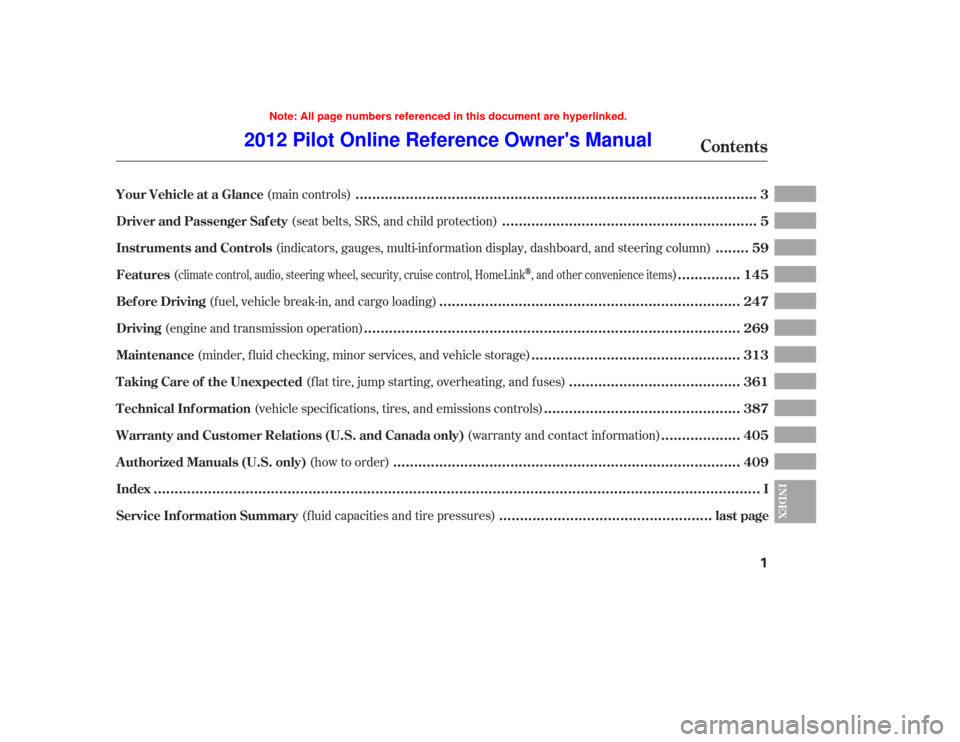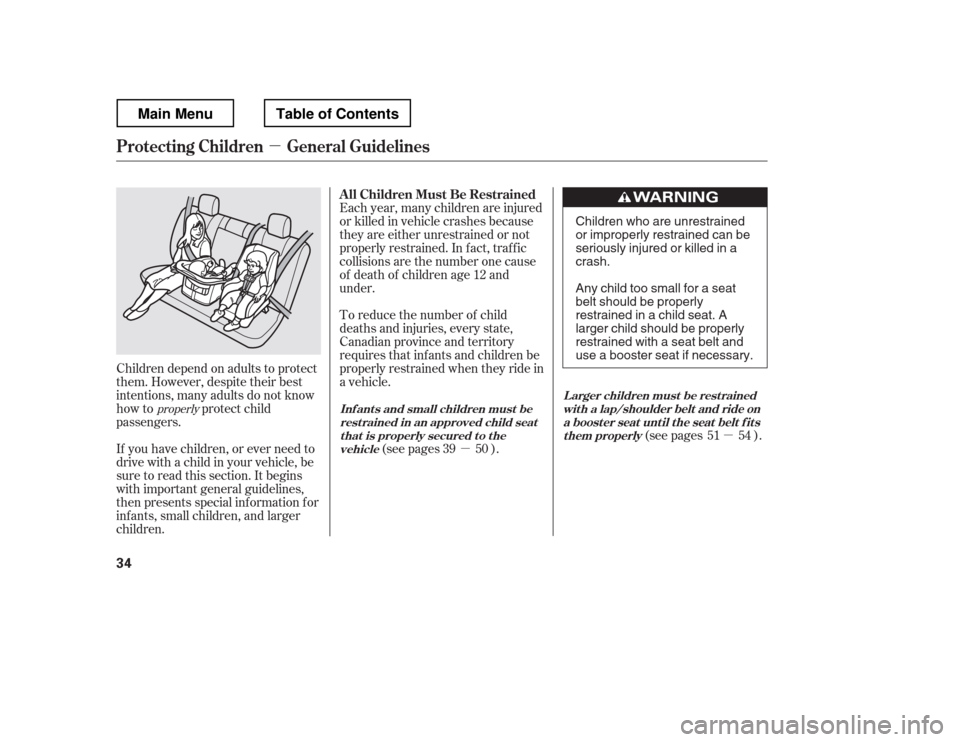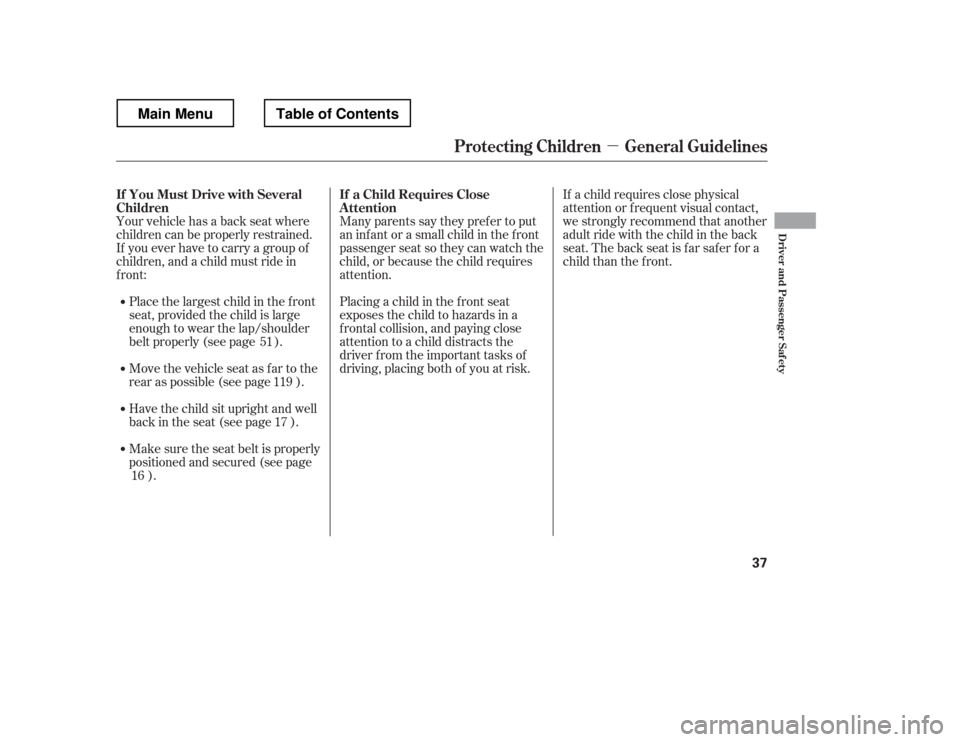Page 8 of 429

(f luid capacities and tire pressures)
(seat belts, SRS, and child protection)
(main controls)
(indicators, gauges, multi-inf ormation display, dashboard, and steering column)
(fuel, vehicle break-in, and cargo loading)
(
)
(engine and transmission operation) (minder, f luid checking, minor services, and vehicle storage)
(f lat tire, jump starting, overheating, and f uses)
(vehicle specif ications, tires, and emissions controls)
(warranty and contact inf ormation)
(how to order)
climate control, audio, steering wheel, security, cruise control, HomeLink, and other convenience items
Contents
................................................................................................................................................
Index .I
..................................................
Service Inf ormation Summary . last page
............................................................
Driver and Passenger Saf ety .5
...............................................................................................
Your Vehicle at a Glance .3
.......
Instruments and Controls .59
.......................................................................
Bef ore Driving .247
..............
Features .145
.........................................................................................
Driving .269
.................................................
Maintenance .313
........................................
T aking Care of the Unexpected .361
..............................................
T echnical Inf ormation .387
..................
Warranty and Customer Relations (U.S. and Canada only) . 405
..................................................................................
A uthorized Manuals (U.S. only) .409INDEX
1
Note: All page numbers referenced in this document are hyperlinked.
2012 Pilot Online Reference Owner's Manual
Page 12 of 429
�µ
This section gives you important
inf ormation about how to protect
yourself and your passengers. It
shows you how to use seat belts. It
explains how your airbags work. And
it tells you how to properly restrain
inf ants and children in your vehicle.
.........
Important Safety Precautions . 6
.......
Your Vehicle
Page 15 of 429
�µ �µ�µ�µ
Your vehicle is equipped with seat
belts in all seating positions.
Seat belts are the single most
effectivesafetydeviceforadultsand
larger children. (Inf ants and smaller
children must be properly restrained
in child seats.)
Not wearing a seat belt properly
increases the chance of serious
injury or death in a crash, even
though your vehicle has airbags.
The pickup bed is not equipped with
seats or seat belts. Do not let anyone
ride in the pickup bed as they can
easily be thrown out and be killed or
seriously injured.
In addition, most states and all
Canadian provinces and territories
require you to wear seat belts.
Your seat belt system also includes
an indicator on the instrument panel
and a beeper to remind you and your
passengers to f asten your seat belts.
Keep you connected to the vehicle
so you can take advantage of the
vehicle
Page 25 of 429
In addition, an occupant who is out of
position in the f ront seat can be
seriously or f atally injured in a crash
by striking interior parts of the
vehicle or being struck by an
inflating front airbag.If you are pregnant, the best way to
protect yourself and your unborn
child when driving or riding in a
vehicle is to always wear a seat belt,
and keep the lap part of the belt as
low as possible across the hips. When driving, remember to sit
upright and adjust the seat as f ar
back as possible while allowing f ull
control of the vehicle. When riding
as a f ront passenger, adjust the seat
as far back as possible.
This will reduce the risk of injuries
to both you and your unborn child
that can be caused by a crash or an
inflating front airbag.
Each time you have a checkup, ask
your doctor if it
Page 36 of 429
To get the best protection f rom the
side airbags, front seat occupants
should wear their seat belts and sit
upright and well back in their seats.Your vehicle has a side airbag cutof f
system designed primarily to protect
a child riding in the f ront passenger
Page 41 of 429

�µ
�µ�µ
If you have children, or ever need to
drive with a child in your vehicle, be
sure to read this section. It begins
with important general guidelines,
then presents special inf ormation f or
infants, small children, and larger
children. To reduce the number of child
deaths and injuries, every state,
Canadian province and territory
requires that inf ants and children be
properlyrestrainedwhentheyridein
a vehicle.
(see pages ). (see pages ).
Children depend on adults to protect
them. However, despite their best
intentions, many adults do not know
how to protect child
passengers. Each year, many children are injured
or killed in vehicle crashes because
they are either unrestrained or not
properly restrained. In f act, traf f ic
collisions are the number one cause
of death of children age 12 and
under.
39 50 51 54
properly
Protecting Children General Guidelines
All Children Must Be Restrained
Inf ant s and small children must be
rest rained in an approved child seat t hat is properly secured t o t hevehicle Larger children must be restrained
wit h a lap/shoulder belt and ride ona boost er seat unt il t he seat belt f it st hem properly
34 Children who are unrestrained
or improperly restrained can be
seriously injured or killed in a crash.
Any child too small for a seat
belt should be properly
restrained in a child seat. A
larger child should be properly
restrained with a seat belt and
use a booster seat if necessary.
Table of ContentsMain Menu
Page 44 of 429

�µ
Many parents say they pref er to put
an inf ant or a small child in the f ront
passenger seat so they can watch the
child, or because the child requires
attention.
Placing a child in the f ront seat
exposes the child to hazards in a
f rontal collision, and paying close
attention to a child distracts the
driver from the important tasks of
driving, placing both of you at risk.
Your vehicle has a back seat where
children can be properly restrained.
If you ever have to carry a group of
children, and a child must ride in
front:
Place the largest child in the f ront
seat, provided the child is large
enough to wear the lap/shoulder
belt properly (see page ). If a child requires close physical
attention or f requent visual contact,
we strongly recommend that another
adult ride with the child in the back
seat. The back seat is far safer for a
child than the front.
Move the vehicle seat as far to the
rear as possible (see page ).
Have the child sit upright and well
backintheseat(seepage ).
Make sure the seat belt is properly
positioned and secured (see page ). 17
16 51
119
If You Must Drive with Several
Children
If a Child Requires Close
Attention
Protecting Children General Guidelines
Driver and Passenger Saf ety
37
Table of ContentsMain Menu
Page 45 of 429

�µ
During a crash, the
belt could press deep into the child
and cause serious or fatal injuries.
If they do, they
could be very seriously injured in a
crash. Children who play in vehicles
can accidentally get trapped inside.
Teach your children not to play in
or around vehicles. Know how to
operate the emergency In-Bed
Trunk opener and decide if your
children should be shown how to
use this f eature (see page ).
Opening or
closing the tailgate could cause
accidental injuries.
Even very young
children learn how to unlock
vehicle doors, turn on the ignition
switch, and open the windows,
which can lead to accidental injury
or death.
If you are not wearing a
seat belt in a crash, you could be
thrown f orward and crush the
child against the dashboard or a
seat-back. If you are wearing a
seat belt, the child can be torn
f rom your arms and be seriously
hurt or killed.
If a child wraps a loose seat belt around their neck, they
can be seriously or f atally injured.
(See pages and f or how to
activate and deactivate the
lockable retractor.)
Leaving children without
adult supervision is illegal in most
states, Canadian provinces and
territories, and can be very
hazardous. This can prevent
children f rom accidentally f alling
out (see page ).
For example, infants and small
childrenleftinavehicleonahot
day can die f rom heatstroke. A
child lef t alone with the key in the
ignition switch can accidentally set
the vehicle in motion, possibly
injuring themselves or others. 46 47
104 117
Additional Saf ety Precautions
Protecting Children General Guidelines
Never put a seat belt over yourself
and a child.
Never let two children use thesame seat belt . L ock all doors and t he In-Bed
T runk when your vehicle is not in use.
T each your children not t o play onthe pickup bed.
K eep vehicle keys/remot etransmitters out of the reach of children.
Neverholdaninfantorchildon
your lap.
Make sure any unused seat beltt hat a child can reach is buckled,the lockable retractor is activated,and the belt is f ully retracted andlocked. Do not leave children alone in a
vehicle.
Use t he childproof door locks t o
prevent children f rom opening t herear doors.
38
Table of ContentsMain Menu